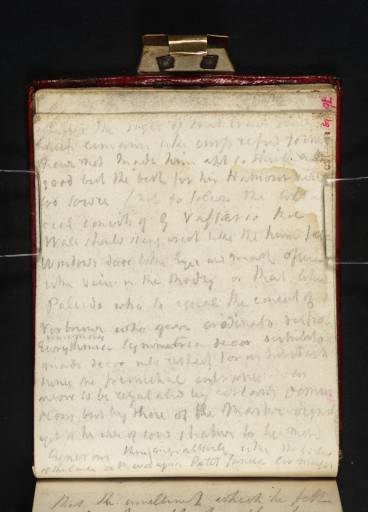Joseph Mallord William Turner Notes from 'The Elements of Architecture' by Sir Henry Wotton (Inscription by Turner) circa 1809-11
Joseph Mallord William Turner,
Notes from 'The Elements of Architecture' by Sir Henry Wotton (Inscription by Turner)
circa 1809-11
Folio 89 Recto:
Notes from ‘The Elements of Architecture’ by Sir Henry Wotton (Inscription by Turner) circa 1809–11
D07734
Turner Bequest CXI 89
Turner Bequest CXI 89
Pencil on white wove paper, 110 x 88 mm
Inscribed by Turner in pencil see main catalogue entry)
Inscribed by John Ruskin in red ink ‘89’ top right, running vertically
Stamped in black ‘CXI 80’ top right, running vertically
Inscribed by Turner in pencil see main catalogue entry)
Inscribed by John Ruskin in red ink ‘89’ top right, running vertically
Stamped in black ‘CXI 80’ top right, running vertically
Accepted by the nation as part of the Turner Bequest 1856
References
1909
A.J. Finberg, A Complete Inventory of the Drawings of the Turner Bequest, London 1909, vol.I, p.302, CXI 89, as ‘Manuscript note’.
Turner’s inscription reads:
whether the sight of many brave things | which remain like impressed forms | have not made him apt to think nothing | good but the best for his Humour were | too sowre / not to follow the artif|icial conceit of G Vassario that | Walls should stand erect like the human face | Windows door like the Eye and Mouth offices | like veins in the Body or that like | Palladio who to equal the conceit of | Vitruvius who gave credentro dextro | Eurythmia Symmetria décor distributio | made décor into respect for inhabitant | whence the primordial entrance was | never to be regulated by certain dimensions | never but by those of the Masters dignity | yet as he was of low stature to be more | generous than ingratiating like the gate | of the Conte de Bevilacqua Patet Janua Cor magis
This passage is the last of a run of notes written backwards through the sketchbook from folio 92 (D07740). All are from The Elements of Architecture by Sir Henry Wotton (1624). Although Turner’s notes broadly follow the order of Wotton’s text, he has been very selective; throwing together a series of fragments as if they were a continuous argument. These notes have not been fully transcribed until now, and have been deciphered by comparison with Wotton’s original. The potted history of ancient artists on folios 90 verso–recto (D07737–D07736) has been ascribed by Jerrold Ziff1 to The Painting of the Ancients by Franciscus Junius (1638) but again the source is Wotton, who quotes numerous authors ancient and modern.
Here Turner, continuing from the verso (D07735), begins by summarising Wotton’s plea to the critic, when examining a work of art, to ‘examine himself’ to see if experience has made him over-critical. Then he cites Wotton’s borrowing of recommendations by Vasari2 and Vitruvius3 on how to judge a building by comparing its parts ‘to the properties of a well shapen man’4 or to the principles that ‘accomplish this whole art’. He finishes by giving Wotton’s example of décor, taken from Palladio,5 of entrances built in proportion to the client’s stature or when disproportionate excused by ‘some noble emblem, or inscription’ like that on the Palazzo Bevilacqua at Verona (transl ‘the door is open but the heart is open wider’).
Here Turner, continuing from the verso (D07735), begins by summarising Wotton’s plea to the critic, when examining a work of art, to ‘examine himself’ to see if experience has made him over-critical. Then he cites Wotton’s borrowing of recommendations by Vasari2 and Vitruvius3 on how to judge a building by comparing its parts ‘to the properties of a well shapen man’4 or to the principles that ‘accomplish this whole art’. He finishes by giving Wotton’s example of décor, taken from Palladio,5 of entrances built in proportion to the client’s stature or when disproportionate excused by ‘some noble emblem, or inscription’ like that on the Palazzo Bevilacqua at Verona (transl ‘the door is open but the heart is open wider’).
Turner seems not have owned Wotton’s book, as he did Junius’s.6 However, he may have read it in the Royal Academy library or in that of his friend John Soane, the Academy’s Professor of Architecture. Again, bearing in mind when this sketchbook was in use, he may have come across Wotton’s text in a new anthology compiled by Walter Scott.7 His voracious reading at this period was in preparation for his own lectures as Professor of Perspective, given from 1811.
David Blayney Brown
May 2011
Jerrold Ziff, ‘Turner, the Ancients, and the Dignity of the Art’, Turner Studies, vol.3, no.2, Winter 1984, p.49 note 15
For a recent discussion of Vasari’s physical analogies for architecture, and the Vitruvian tradition of architecture as bodily representation see John Peacock, ‘Inigo Jones as a Figurative Artist’, in Lucy Gent and Nigel Llewellyn eds., Renaissance Bodies: the Human Figure in English Culture, c.1540–1660, pp.164–5.
How to cite
David Blayney Brown, ‘Notes from ‘The Elements of Architecture’ by Sir Henry Wotton (Inscription by Turner) c.1809–11’, catalogue entry, May 2011, in David Blayney Brown (ed.), J.M.W. Turner: Sketchbooks, Drawings and Watercolours, Tate Research Publication, December 2012, https://www

